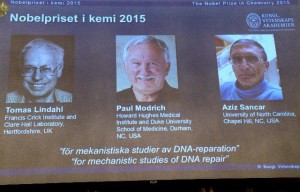The Nobel Prize in Chemistry 2015 has been awarded to Tomas Lindahl, Paul Modrich and Aziz Sancar “for mechanistic studies of DNA repair.” The three scientists outlined chemical pathways that cells in living things, including human beings, use to repair damaged DNA. “Their work has provided fundamental knowledge of how a living cell functions and is, for instance, used for the development of new cancer treatments,” the academy said.
The organization tweeted graphics explaining the scientists’ work. Lindahl, a Swedish scientist, showed that “DNA decays at a rate that ought to have made the development of life on Earth impossible,” the academy said. “This insight led him to discover a molecular machinery, base excision repair, which constantly counteracts the collapse of our DNA.” Modrich, an American, showed how a cell corrects errors that occur when DNA is replicated during cell division. “This mechanism, mismatch repair, reduces the error frequency during DNA replication by about a thousandfold,” the academy said. “Congenital defects in mismatch repair are known, for example, to cause a hereditary variant of colon cancer.”Sancar, a U.S. and Turkish citizen, mapped nucleotide excision repair, the mechanism that cells use to repair UV damage to DNA, the academy said. “People born with defects in this repair system will develop skin cancer if they are exposed to sunlight, it said.
This chemistry guards our genomes from the damage that occurs from UV radiation and cigarette smoke , as well as normal wear and tear. Göran K. Hansson, Permanent Secretary of the Royal Swedish Academy of Science, made the announcement this morning in Stockholm. The laureates’ findings “have enormous consequences,” said Nobel Chemistry Committee Chair Sara Snogernup Linse, Professor of Physical Chemistry & Molecular Protein Science at Lund University. “They have led to insights into what may go wrong in diseases such as cancer,” and what contributes to aging, she added.
Though their discoveries are related, today’s trio of laureates worked independently of one another. They started their investigations in simple living things such as bacteria or yeast and eventually, after years or decades, proved their work was also applicable in humans.The story begins with a Nobel hometown son, Tomas Lindahl, born in Stockholm but today of the Francis Crick Institute and Clare Hall Laboratory in the United Kingdom. Nobel buffs will recall that Crick, James Watson and Maurice Wilkins won the 1962 Nobel Prize in Physiology or Medicine for discovering the structure of DNA. Until the early 1970s, researchers thought that DNA was a rather stable structure. Lindahl’s work demonstrated otherwise. He showed that cells play host to spontaneous chemical processes that break down DNA slowly, but noticeably. According to his calculations, genomes would build up thousands of DNA defects every day, far too many to support the development of life on Earth. He reasoned there must be a way to fix this damage.
Sure enough, Lindahl found a repair mechanism. Today it is known as base excision repair. DNA contains 4 chemical building blocks, each with a different nitrogen containing portion known as the base. When spontaneous damage changes the chemical structure of a DNA base, it could lead to a mutation the next time that DNA is copied, for instance, when a cell divides. Lindahl showed that cells contain specialized proteins enzymes that can detect these defects, snip out the damaged base, and put back the correct base. He first published this discovery in 1974.”This insight led him to discover a molecular machinery, base excision repair, which constantly counteracts the collapse of our DNA.”

